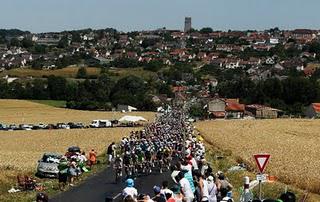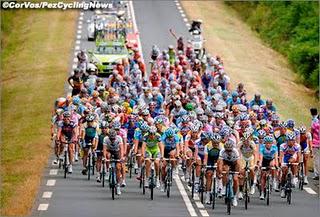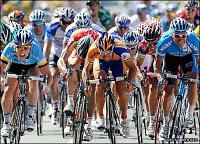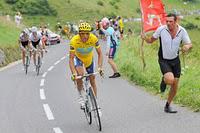by Conroy Every July the world gets to witness one of the great sporting spectacles - the Tour de France. Over the course of three weeks, nearly two hundred of the world's best cyclists traverse the roads of France. In the process of 21 racing days the riders will cover more than 2,000 miles, from the flat roads of northern France to the mountains of the Pyrenees and Alps, and ending on the Champs-Elysees in Paris.
Every July the world gets to witness one of the great sporting spectacles - the Tour de France. Over the course of three weeks, nearly two hundred of the world's best cyclists traverse the roads of France. In the process of 21 racing days the riders will cover more than 2,000 miles, from the flat roads of northern France to the mountains of the Pyrenees and Alps, and ending on the Champs-Elysees in Paris.
I like niche sports like cycling, but the uniqueness of Le Tour is compelling to even casual sports fans (or non-sports fans for that matter). Here are some reasons to watch the remaining twelve stages (two weeks) of this year's edition:
Beauty of France First and foremost, the Tour offers its participants, spectators, and television viewers a chance to experience the beauty of France in summer. Each Tour crisscrosses the country, passing through distinct regions and the wonderful variety of French landscapes and townscapes. For its size, France must surely offer some of the finest combinations of contrasting topography, cities large and small, picturesque towns and villages, and the captivating contrast of historical structures (like castles and chateau) and modern creations (like new bridges and buildings).
First and foremost, the Tour offers its participants, spectators, and television viewers a chance to experience the beauty of France in summer. Each Tour crisscrosses the country, passing through distinct regions and the wonderful variety of French landscapes and townscapes. For its size, France must surely offer some of the finest combinations of contrasting topography, cities large and small, picturesque towns and villages, and the captivating contrast of historical structures (like castles and chateau) and modern creations (like new bridges and buildings).
Personally, I like that on any individual stage, and a typical road stages cover more than 100 miles, the race course will pass by agricultural fields, several towns/cities, stands of woods, and open countryside. Stages can be largely flat or radically undulating, travel along the coast or past vineyards, or through large cities and tiny hamlets, and often many of these in the same day. Mostly the Tour is bathed in bright sunlight (though rain in France is common in July) which beautifully highlights the dark green foliage and light colored buildings. The Tour organizers are also keen to vary the type of roads during each day, which includes freeways, boulevards, and narrow country lanes. This approach ensures that each day offers views of locations rarely seen by non-locals.
The Tour is greatly helped by the French TV that covers the event with what seems to be dozens of cameras including daredevil motorbike cameramen for close shots of the riders and roadside, and helicopters that offer expansive aerial views. There could be no better tourist advertisement than the daily coverage of the Tour. I'm sure anyone who spends a few minutes watching will be captivated and wish they were traveling in the places they see. Certainly this is my perspective.
Traveling Carnival

The peloton
Of course the Tour is far larger than just the 200 riders that make up the competition. Each team, 22 are entered, includes not only riders, but directors, mechanics, chefs, doctors, and physiologists. The Tour organization includes officials and referees, sponsors, local dignitaries, and other invited guests. The Tour is followed by a convoy of French and international media. Together, these groups make up a sporting circus of hundreds of vehicles and thousands of people. Each day the Tour takes over the city or town near the day's finish or the next day's start. This traveling carnival is a huge event in and of itself.
With each stage the carnival is on the move. As the tour progresses, the race route roads are closed as the Tour approaches. The riders are preceded by a parade of tour vehicles, usually sponsor vehicles that often throw out give-aways to the waiting spectators.
During the day's race, an armada of team cars and official vehicles accompany the riders, who are usually grouped in a large mass - the peloton. The peloton is wonderful to watch. Each team, in order to gain attention for their sponsors and riders, is attired in bright colors and distinctive patterns. Together, the group appears as a mesmerizing rainbow. Riders group closely together because the effects of drafting help individual riders conserve energy, essential in a sport where riders burn way more calories each day than they can possibly consume. As a result, riders are experienced in following the wheel of the riders in front and around them. Watch the peloton flow around a roundabout and you'll see the skill and experience of the pack which from above appears to behave like a flock of birds or school of fish.
Bicycle Racing

Sprint finish
Each stage almost invariably features a breakaway of riders that escape from the peloton to try to win the day. They rarely succeed, but it is enjoyable to watch the peloton chase down the breakaway (or root for the breakaway to survive), usually catching the small group only a short distance before the finish. Near the end of "flat" stages, the riders will string-out as the teams of fast sprinters push the speed of the group to over 40 mph as the bunch powers to the finish. On mountain stages, the group will quickly splinter as the strong mountain riders "drop" the weaker and heavier riders. It's amazing to see the strong climbers accelerate on steep mountain roads to test and challenge one another. Even the inexperienced viewer will recognize the remarkable aerobic ability of these finely-conditioned athletes. On the descent from a mountain pass, riders will travel in a long thin line and snake down narrow, twisting roads and switchbacks; all at speeds that can approach a death-defying 70 mph.
Of course each day can be marred by crashes, the downside to such fast, close, and aggressive riding through varying roadway and weather conditions.

Mountain attack
Free Spectacle
Finally, the Tour de France is almost certainly the largest annual spectator sporting event in the world. Literally millions of people line the course route over the three weeks of the competition. All of those spectators get to watch the event for free. At the finish or along the final climb of a mountain stage, thousands of spectators will cheer the riders on. Perhaps the most gratifying aspect of the tour is the fact that spectators, almost without exception, cheer all of the riders regardless of team or nationality.

Massive crowd surrounding riders
The presence of cheering spectators enlivens the event especially when the crowd is so large that it spills onto the road around the leaders as they slowly climb to the highest mountain passes (of course this can be disruptive and unnerving to the riders as well). Spectators will color the road with chalk supporting riders, teams, and national or regional colors. Flags of many nations and regions (i.e. Breton, Basque) pepper the roadside. In fact, the course route on some roads, especially mountain roads, is closed many hours before and after the tour passes through. The spectators make the roadside an area for camping and partying. The route itself is open for amateur riders. In how many other events can bystanders freely use the "playing" surface?
I credit the French organizers for often taking parts or entire stages to nearby countries, like Spain, Italy, Germany, or Belgium; the Tour has even visited England and Ireland (it visits Italy this year). This expands the appeal of the race, which is always enthusiastically supported by the non-French populations.
---
As I've written, the Tour de France has been tainted in recent years by numerous doping scandals. The latest rumors surrounding Lance Armstrong and other top riders threaten the very legitimacy of professional cycling. This is a great pity. The Tour de France is a wonderful event and is viable no matter how fast the riders pedal, or what individual or team wins. To borrow a French phrase, Vive le Tour. I know I'll enjoy the next two weeks and not least because of the great spectacle.

